Murray, Hugh Cornelius (Pilot Officer)
Prisoner of War 1944-December-11


Birth Date: unkown date
Born:
Home:
Enlistment:
Enlistment Date: Unknown
Service
RCAF
Unit
417 Sqn- Squadron
Supporting Liberty and Justice
Base
Rank
Pilot Officer
Position
Pilot Officer
Service Numbers
J/90425
PoW: 6884
Crew or Other Personnel
Spitfire JF952
Spitfire serial: JF952
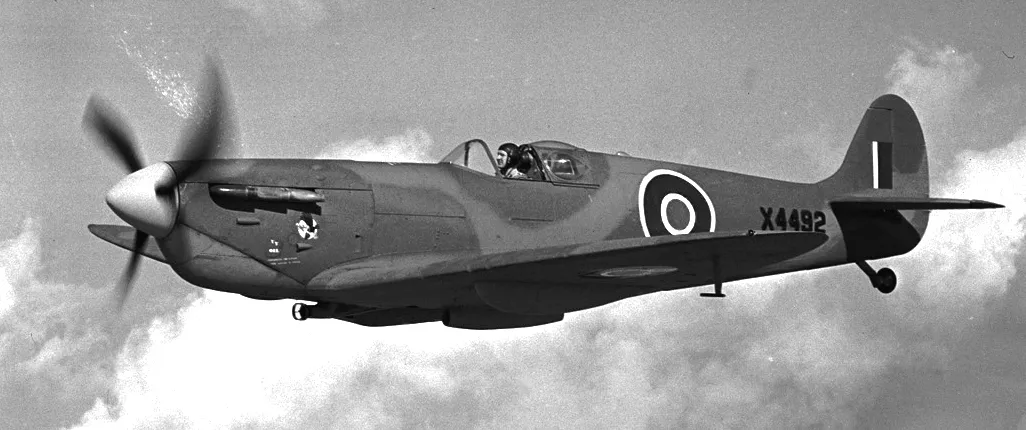
Supermarine Spitfire Mk. VI, RCAF (Serial No. X4492), in flight, 26 Feb 1944.
The Supermarine Spitfire is a British single-seat fighter aircraft that was used by the Royal Air Force and other Allied countries before, during, and after World War II. Many variants of the Spitfire were built, using several wing configurations, and it was produced in greater numbers than any other British aircraft. It was also the only British fighter produced continuously throughout the war. The Spitfire continues to be popular among enthusiasts; around 70 remain airworthy, and many more are static exhibits in aviation museums throughout the world.
The Spitfire was designed as a short-range, high-performance interceptor aircraft by R. J. Mitchell, chief designer at Supermarine Aviation Works, which operated as a subsidiary of Vickers-Armstrong from 1928. Mitchell pushed the Spitfire's distinctive elliptical wing with cutting-edge sunken rivets (designed by Beverley Shenstone) to have the thinnest possible cross-section, helping give the aircraft a higher top speed than several contemporary fighters, including the Hawker Hurricane.
The Spitfire had detachable wing tips which were secured by two mounting points at the end of each main wing assembly. When the Spitfire took on a role as a high-altitude fighter (Marks VI and VII and some early Mk VIIIs), the standard wing tips were replaced by extended, "pointed" tips which increased the wingspan from 36 ft 10 in (11.23 m) to 40 ft 2 in (12.24 m). The other wing-tip variation, used by several Spitfire variants, was the "clipped" wing; the standard wing tips were replaced by wooden fairings which reduced the span by 3 ft 6 in (1.07 m). The wing tips used spruce formers for most of the internal structure with a light alloy skin attached using brass screws.
Due to a shortage of Brownings, which had been selected as the new standard rifle calibre machine gun for the RAF in 1934, early Spitfires were fitted with only four guns, with the other four fitted later. Early tests showed that, while the guns worked perfectly on the ground and at low altitudes, they tended to freeze at high altitude, especially the outer wing guns, because the RAF's Brownings had been modified to fire from an open bolt. While this prevented overheating of the cordite used in British ammunition, it allowed cold air to flow through the barrel unhindered. Supermarine did not fix the problem until October 1938, when they added hot air ducts from the rear of the wing-mounted radiators to the guns, and bulkheads around the gunbays to trap the hot air in the wing. Red fabric patches were doped over the gun ports to protect the guns from cold, dirt, and moisture until they were fired.
The first Rolls-Royce Griffon-engined Mk XII flew in August 1942, and first flew operationally with 41 Squadron in April 1943. This mark could nudge 400 mph (640 km/h) in level flight and climb to an altitude of 33,000 ft (10,000 m) in under nine minutes. As American fighters took over the long-range escorting of USAAF daylight bombing raids, the Griffon-engined Spitfires progressively took up the tactical air superiority role, and played a major role in intercepting V-1 flying bombs, while the Merlin-engined variants (mainly the Mk IX and the Packard-engined Mk XVI) were adapted to the fighter-bomber role. Although the later Griffon-engined marks lost some of the favourable handling characteristics of their Merlin-powered predecessors, they could still outmanoeuvre their main German foes and other, later American and British-designed fighters.Wikipedia
 Wikipedia Supermarine Spitfire
Wikipedia Supermarine Spitfire
Unit Desciption
417 Sqn Supporting Liberty and Justice ("City of Windsor")
History of the Squadron during World War II (Aircraft: Hurricane Mks. IIB, IIC, Spitfire Mks. VB, VC, VIII, IXB)
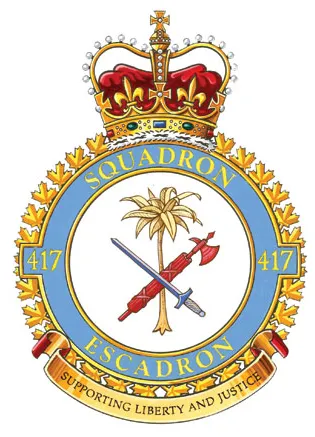
No. 417 Squadron was the 16th RCAF squadron formed overseas in WWII. It was the seventh fighter squadron, and was formed at Charmy Down, Somerset, England in November 1941. After 4 months in England and Scotland, the squadron sailed to Egypt where it flew Hawker Hurricanes and, later, Supermarine Spitfires in the defence of the Suez Canal and the Nile Delta. It became the only Canadian squadron in the Desert Air Force, and provided air defence and ground support to the British Eighth Army as it advanced from El-Alamein to Tunisia. It was in Malta to support Operation HUSKY, the invasion of Sicily in Jun-Jul 1943, and then provided support for the army in its campaign through Italy. It was disbanded at Treviso, Italy on June 30, 1945.
Overall the squadron flew 12,116 sorties. It claimed 29 enemy aircraft destroyed, 8 probables and 22 damaged, for the loss of 32 aircraft and 28 pilots of whom 7 were killed, 11 presumed dead, 8 were POW and 2 evaded capture. The squadron also accounted for many locomotives, rail cars, tanks and other vehicles. There was one ace among the pilots, Squadron Leader A.U. Houle, DFC & Bar. Squadron personnel were awarded 1 DSO, 1 Bar to DFC, 9 DFCs and 5 MiDs. Battle Honours were: Defence of Britain 1942, Egypt and Libya 1943-43, North Africa 1943, Sicily 1943, Italy 1943-45, Salrno, Anzio and Nettuno, Gustav Line, Gothic Line.Wikipedia, Kostenuk and Griffin
Maps for Movements of 419 Squadron 1942-45
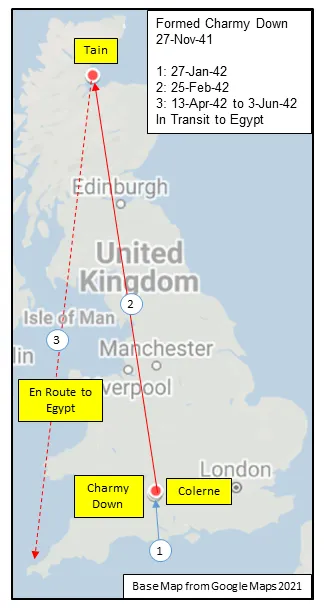
MAP 1: 417 Squadron Movements in Britain 1941-42 (right-click on image to display enlarged in new tab)
|
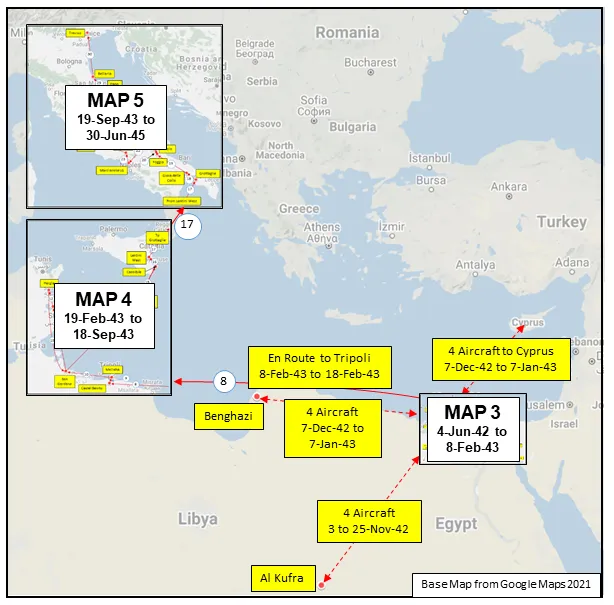
MAP 2: 417 Squadron Movements in North Africa and Mediterranean Theatre
|
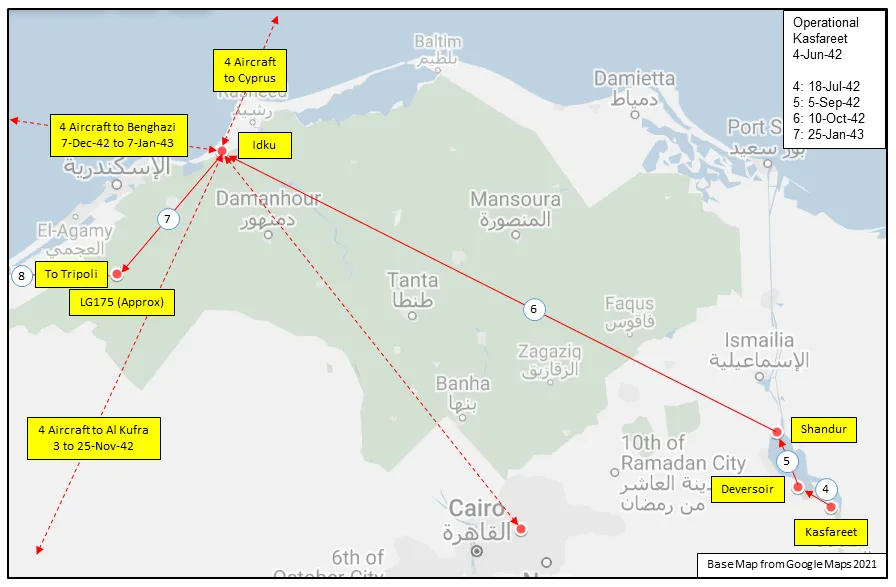
MAP 3: 417 Squadron Movements in Egypt 1942-43 (detail of Map 2)
|
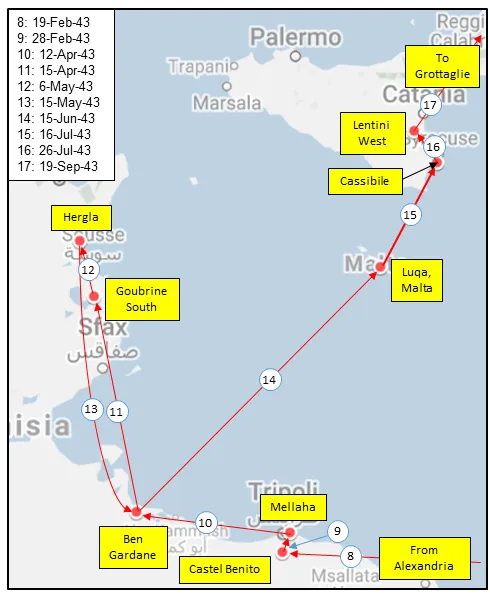
MAP 4: 417 Squadron Movements in Tunisia and Sicily 1943 (detail of Map 2)
|
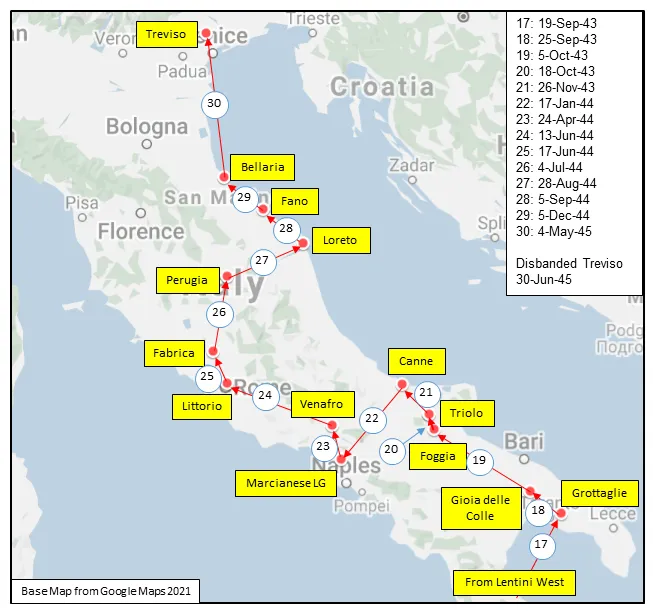
MAP 5: 417 Squadron Movements in Italy 1943-45 (detail of Map 2)
|
417 Squadron History Summary 1941-45
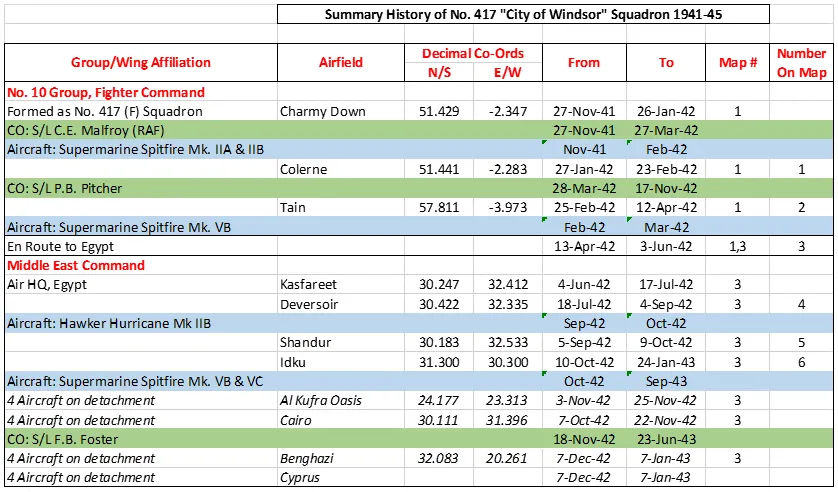
417 Squadron History Summary 1941-45 Page 2
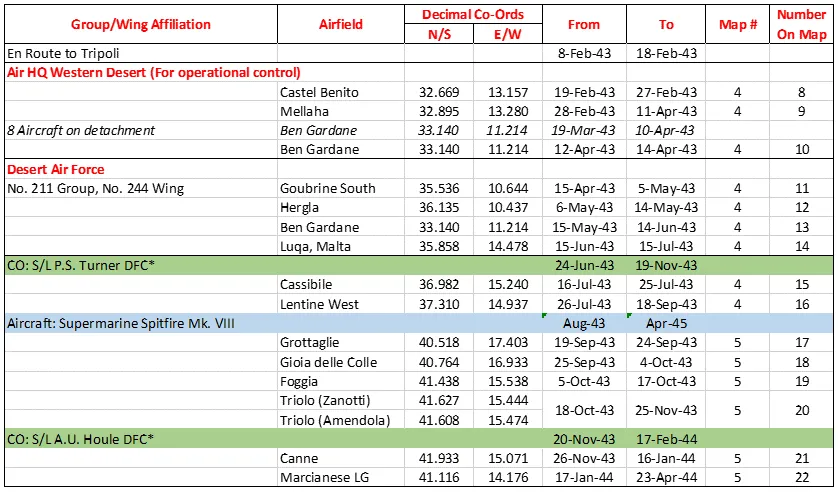
417 Squadron History Summary 1941-45 Page 3
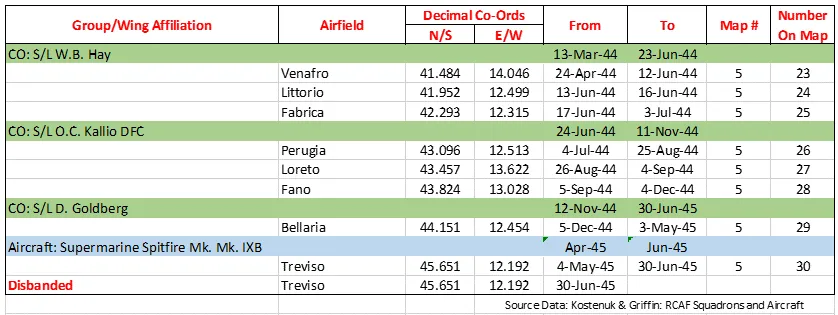
History of the Squadron Post-WWII (Aircraft: Mustang IV, Harvard II, Starfighter, Expeditor, Silver Star, Dragonfly, Huey, Iroquois, Griffon)
417 Squadron was reformed and disbanded twice since its original period of activity. The Squadron was reactivated on June 1, 1947 as a Fighter Reconnaissance Squadron at RCAF Station, Rivers, Manitoba , where it flew North American Mustangs and Harvards in the close air support role until August 1, 1948, when it was disbanded.
Twenty-two years later, in 1970, 417 Squadron was again reformed, but from the No. 6 (Strike and Reconnaissance) Operational Training Unit (OTU) at CFB Cold Lake, Alberta , which had been training pilots on the CF104 Starfighter since 1961. 417 continued as the CF104 OTU until the Squadron was disbanded in April 1983, as a result of the phasing out of the Starfighter.
During one of 417 Squadron's periods of inactivity, Base Flight at Cold Lake was formed on 24 August 1954. Its original reason for being was to provide a communications link to Edmonton, then five hours away by road. The Flight performed this with their first Aircraft, a Beechcraft Expeditor. In the process of expanding its role, Base Flight amassed a wide variety and number of aircraft, making it one of the largest and most active flying units in Canada's post-war Air Force. The fleet included H-5 (Dragonfly) and H-34 (Horse) helicopters, de Havilland Otters and the Douglas C-47 Dakotas, three of which were modified with nose cones to efficiently train upcoming CF 104 pilots on air intercept radar systems. Base Flight also employed the T-33 Silver Star as utility transport, airborne target trainer and as an air combat adversary. On the helicopter side, the main roles were, and still are, to rescue downed aircrew and to provide Medical Evacuation services (MEDEVAC) to both military and civilian communities. To fulfil these and other diverse roles, Base Flight added to the two original above-mentioned helicopters by receiving three UH-1 Huey or Iroquois helicopters and later, two CH-135 Twin Huey Aircraft. On April 1, 1993, 417 Squadron was re-formed again, incorporating the Base Flight plus aircraft servicing and maintenance elements of the Wing Maintenance organization.
The mission is now to provide helicopter support to 4 Wing, Cold Lake, by providing a dedicated on base Search and Rescue Unit. The unit’s primary role is to conduct Base rescue for the fighter units on base. Its secondary role is to augment the National Search and Rescue capability.
 Library and Archives Canada Service Files (may not exist)
Library and Archives Canada Service Files (may not exist) Harold A Skaarup Web Page
Harold A Skaarup Web Page YouTube How the Spitfire Became an Aviation Masterpiece
YouTube How the Spitfire Became an Aviation Masterpiece RCAF Supermarine Spitfire Serials - Kestrel Publications
RCAF Supermarine Spitfire Serials - Kestrel Publications